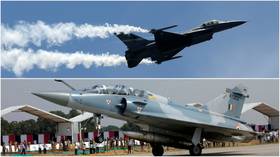Indian Air Force claims tech failures hampered success in aerial battles with Pakistan – report

Airstrikes against ‘terrorist’ targets in Pakistan and subsequent aerial battles with Islamabad’s warplanes would have been more successful if India had better technology, a service report cited by local media admits.
The Indian Air Force’s ‘lessons learnt’ assessment primarily covered February’s retaliatory airstrike on a suspected jihadist training camp in Balakot, Pakistan, resulting in a military flare-up with its neighbor. It found that IAF warplanes would have been able to do serious damage to their Pakistani adversaries – if they had access to weapons capable of doing so in the first place.
The wording of the report was somewhat careful about admitting this fact openly, suggesting that they would have been able to compete with their opponents more effectively if they had possessed “technological asymmetry.”
Also on rt.com Pakistani FM claims India is behind terrorist groups in Balochistan provinceA litany of technical issues was found to have hampered the IAF’s combat prowess. On top of problems integrating new weapons with the available hardware, one of the fighter jet’s missiles apparently failed to deploy from the aircraft altogether due to issues with its navigation system. The same issue had featured in an earlier embarrassing report which suggested that India had likely shot down its own helicopter with a malfunctioning missile while attempting to target encroaching enemy craft.
The latest review also noted that since 1999’s Kargil War, Pakistan “has been consistently enhancing its air defense and offensive capabilities,” demonstrated in the recent clashes by their use of F-16 fighter jets, giving Islamabad an edge. India’s hardware, meanwhile, has become increasingly outdated.
Also on rt.com Beware of the bomber biker! Indian intelligence warns of possible suicide attacks during elections“We felt we could not punish the adversaries appropriately. So we need to bolster technological asymmetry so that the enemy does not even dare to come close to the border,” one source told India’s Economic Times. While things didn’t go exactly as expected, the report reminds readers that “no battle plan ever survives the first contact with the enemy.”
India also maintained that it carried out the assault into Pakistani airspace in order to strike a training facility used by the terrorist group Jaish-e-Mohammad (JeM), which had carried out an attack in Pulwama, killing 40 Indian troops. However, Pakistan has consistently denied the existence of such camps, and said that the raid had merely destroyed some trees.
Like this story? Share it with a friend!













